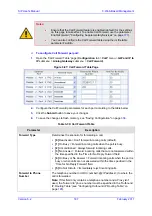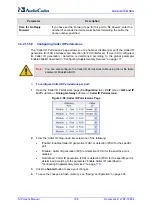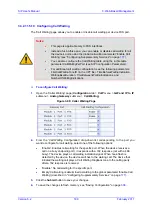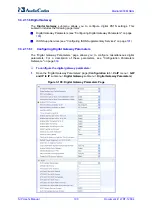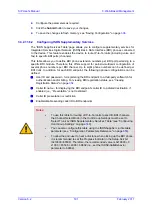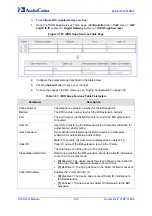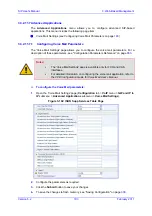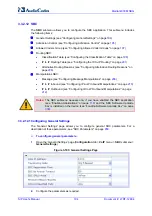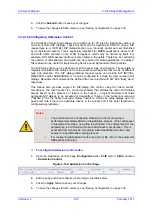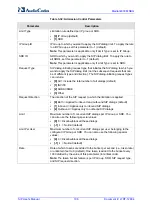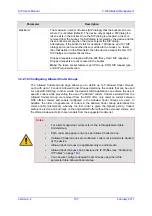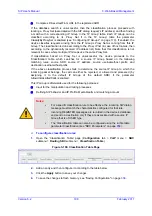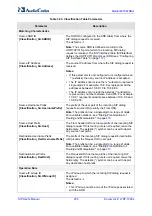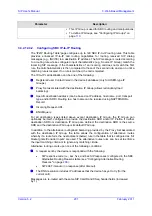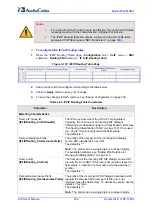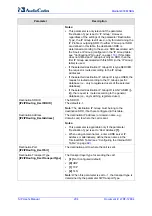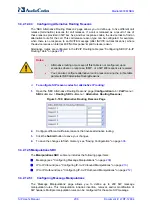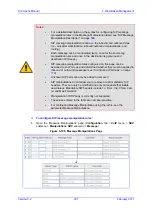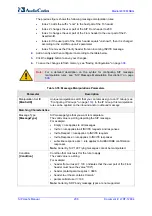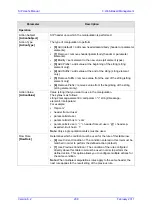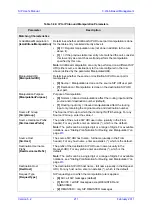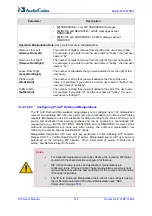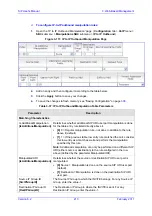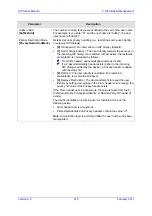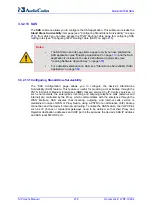
Version 6.2
201
February 2011
SIP User's Manual
3. Web-Based Management
Parameter
Description
This IP Group is used for SBC routing and manipulations
To define IP Groups, see ''Configuring IP Groups'' on
page
3.3.2.12.4.2 Configuring SBC IP-to-IP Routing
The 'IP2IP Routing Table' page configures up to 120 SBC IP-to-IP routing rules. This table
provides enhanced IP-to-IP call routing capabilities for routing received SIP dialog
messages (e.g., INVITE) to a destination IP address. The SIP message is routed according
to a routing rule whose configured input characteristics (e.g., Source IP Group) match the
incoming SIP message. If the characteristics of an incoming call does not match the first
rule, the call characteristics is then compared to those of the second rule, and so on until a
matching rule is located. If no rule is matched, the call is rejected.
The IP-to-IP call destination can be one of the following:
Registered user Contact listed in the device's database (only for USER-type IP
Groups).
Proxy Set associated with the destination IP Group (allows redundancy/load
balancing).
Specific destination address (can be based on IP address, host name, port, transport
type, and/or SRD). Routing to a host name can be resolved using NAPTR/SRV/A-
Record.
Incoming Request-URI.
ENUM query.
For all destination types listed above except destination IP Group, the IP Group can
optionally be itself, configured to provide the destination SRD and/or IP Profile. If neither
destination SRD nor destination IP Group are defined, the destination SRD is the source
SRD and the destination IP Group is its default IP Group.
In addition to the alternative routing/load balancing provided by the Proxy Set associated
with the destination IP Group, the table allows the configuration of alternative routes
whereby if a route fails, the next adjacent (below) rule in the table that is configured as 'Alt
Route Ignore/Consider Inputs' are used. The alternative routes rules can be set to enforce
the input matching criteria or to ignore any matching criteria.
Alternative routing occurs upon one of the following conditions:
A request sent by the device is responded with the following:
•
SIP response code (i.e., 4xx, 5xx, and 6xx SIP responses) configured in the SBC
Alternative Routing Reasons table (see ''Configuring Alternative Routing
Reasons'' on page
).
•
SIP 408 Timeout or no response (after timeout).
The DNS resolution includes IP addresses that the device has yet to try (for the
current call).
Messages are re-routed with the same SIP Call-ID and CSeq header fields (increased
by 1).
Summary of Contents for Mediant 800 MSBG
Page 2: ......
Page 366: ...SIP User s Manual 366 Document LTRT 12804 Mediant 800 MSBG Reader s Notes ...
Page 372: ...SIP User s Manual 372 Document LTRT 12804 Mediant 800 MSBG Reader s Notes ...
Page 390: ...SIP User s Manual 390 Document LTRT 12804 Mediant 800 MSBG Reader s Notes ...
Page 404: ...SIP User s Manual 404 Document LTRT 12804 Mediant 800 MSBG Reader s Notes ...
Page 616: ...SIP User s Manual 616 Document LTRT 12804 Mediant 800 MSBG Reader s Notes ...
Page 636: ...SIP User s Manual 636 Document LTRT 12804 Mediant 800 MSBG Reader s Notes ...
Page 652: ...SIP User s Manual 652 Document LTRT 12804 Mediant 800 MSBG Reader s Notes ...
Page 886: ...SIP User s Manual 886 Document LTRT 12804 Mediant 800 MSBG Reader s Notes ...

